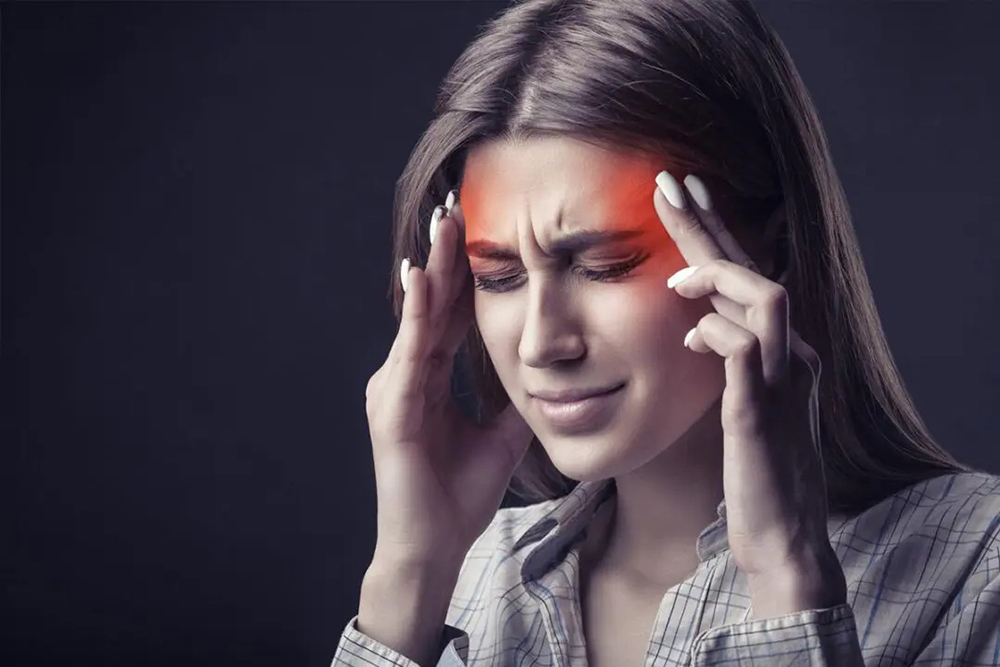|
Getting your Trinity Audio player ready...
|
Acupuncture, acupoint massage, and natural therapies such as herbal teas and diets in TCM have been well-known for thousands of years in China.
By: Naiwen Hu
Studies have confirmed that acupoint massage, medicinal tea, and diet in traditional Chinese medicine (TCM) can relieve or treat headaches and dizziness.
TCM believes that headaches and dizziness are caused by cerebral ischemia and hypoxia due to insufficient qi and blood. Employing natural therapies such as acupoint massage, herbal teas, and herbal meals, through blood replenishing, blood circulation, blood activation, and heat-clearing, can regulate qi and blood and refresh the mind.
Modern-day stressors and a fast-paced lifestyle can easily cause headaches. In general, people with headaches have the following five habits in common:
They put too much pressure on themselves.
They often have poor posture.
They overindulge in cold foods.
They do not blowdry their hair completely dry after washing it.
They are overworked.
Therefore, to eliminate headaches, you must first eliminate these unhealthy habits. At the same time, you can also try some simple and effective TCM tricks.
Acupoints Massage
Massaging relevant acupoints is a simple and easy way to quickly relieve the symptoms of headaches, dizziness, and migraines. The principle behind acupoint massage is to regulate the flow of qi and blood by stimulating specific acupoints on the hands, feet, head, neck, and other parts, thereby correcting the incorrect state of the relevant body parts.
Acupuncture, acupoint massage, and natural therapies such as herbal teas and diets in TCM have been well-known for thousands of years in China, and there is increasing research and practice in the West exploring this ancient wisdom.
A research report published in the Journal of the American Medical Association (JAMA) stated that, in a 24-week randomized clinical trial involving 249 patients with migraine without aura, researchers found that compared with sham acupuncture and those on the acupuncture waiting list as control, there was a significant reduction in frequency of migraine recurrence for those having undergone true acupuncture treatment.
The following are several acupoints commonly employed to treat headaches. The way to massage is to press the acupoints with your thumb or index finger with moderate intensity. The number of times the massage is done varies; you can adjust it at any time according to your preferences.
- Qiuxu Acupoint
The Qiuxu acupoint is at a depression on the front of the outer ankle. Massaging this acupoint can treat migraines. If you have a headache on the right side, press the Qiuxu acupoint on the left ankle, and vice versa. Massaging this acupoint for about three to four seconds should relieve the pain.
- Chize Acupoint
The Chize acupoint is located on the inside of the arm, the deepest point in the elbow fossa when the arm is bent. If the carotid arteries are constricted, blood will be blocked and challenging to transport upward, thus reducing the blood supply up to the brain, resulting in stiffness and pain in the neck, headache, and dizziness. Repeatedly pressing the Chize acupoint will help relieve stiffness in the neck.
Press the left Chize, and the left side of the neck will become relaxed and can move. Pressing the right Chize will release the right side of the neck. This can allow expansion of the carotid arteries, thus reducing the pressure and allowing unimpeded blood flow to the head, thereby relieving and treating headaches.
- HeGu and Lieque Points
The HeGu lies in the groove between the thumb and forefinger. The Lieque acupoint is on the lower wrist.
Cold air blowing directly on the top of the head can easily cause headaches because the wind and cold entering the head will block or slow the circulation of qi and blood, leading to headaches. Ancient literature had records showing that massaging the HeGu and Liequ acupoints alternately can treat pain in the head and face. This is a very effective method for improving headaches, especially migraines.
- YongQuan Point
The YongQuan acupoint lies in the depression at the bottom of the foot, about one-third of the way from the front to the back. Massaging this acupoint can relieve any kind of headache. You can press either the left or right YongQuan acupoint. You can also massage this point by walking barefoot on a trail. The pebbles will stimulate the YongQuan and other acupoints on the bottoms of the feet. “treating a headache by activating the foot” is widely used in clinical practice. When the qi in the head is too strong and causes a headache, by stimulating the soles, the qi will come toward the feet, relieving the head of the excessive qi and relieving the headache.
Herbal Teas
Drinking herbal tea is a convenient and practical way to replenish blood, clear heat, soothe the nerves, and tonify the kidneys, among other things. It is found to have a preventive and therapeutic effect on headaches and dizziness. Here are some common medicinal teas.
Wolfberry Tea
Wolfberry is a traditional Chinese medicinal herb that protects the eyes, improves eyesight, and nourishes yin, blood, the liver, and the kidneys, to name a few. It can treat headaches and dizziness caused by kidney deficiency or liver fatigue. Prepare wolfberry tea with 10 to 20 grams (0.4 to 0.7 ounce) of wolfberry, brew it with boiling water, and drink it. Wolfberry tea can be taken daily to nourish the skin and improve physical strength.
Red Dates, Cinnamon, and Ginger Tea
Red dates can replenish qi and blood, strengthen the spleen, and treat headaches and dizziness caused by insufficient qi and blood. Ginger is widely used in TCM for its warming and analgesic properties. It can, therefore, be used to treat headaches and dizziness caused by the invasion of wind and cold.
Cinnamon also has a warming effect and can guide qi to return to its origin—that is, drive it to the most critical places in the body, Mingmen (the lower back area), and the kidneys. To make this tea with red date and ginger, start with 10 to 20 grams (0.4 to 0.7 ounce) of red dates, 5 to 10 grams (0.2 to 0.4 ounce) of shredded ginger, 3 to 5 grams (0.1 to 0.2 ounce) of cinnamon, and an appropriate amount of brown sugar. Boil it with water and drink it as tea to replenish qi and blood and relieve headaches.
Making a Medicinal Diet
Adding medicinal herbs to meals is a delicious and nutritious way to replenish blood, qi, kidneys, clear heat, etc. The principle behind medicated meals is to select some Chinese medicinal herbs with specific properties to add to food. The right herbs and foods can combat headaches and dizziness. The following is a soup that has several kinds of medicinal foods.
Milkfish Head Soup
Milkfish is a marine fish rich in protein, calcium, iron, zinc, and other nutrients. It can nourish the kidneys and blood, replenish qi, soothe the mind, etc.
Boil 3 to 5 milkfish heads.
Add Gastrodia elata, Poria cocos, Codonopsis pilosula, chamomilein, and 2,000 cubic centimeters (68 fl. ounces) of water. Cook for about 20 minutes.
Add 1 piece of cut tofu and cook for another 5 minutes.
Add Uncaria, then stir thoroughly, and add seasoning before serving.
The whole family can eat this soup to soothe the nerves and nourish the brain. Milkfish head, Gastrodia elata, Codonopsis pilosula, etc., nourish the spleen and stomach and remove excess moisture. They also will address headaches and dizziness.
Gastrodia elata has more than 81 compounds, amongst which phenols and polysaccharides are usually considered to be the most active. A type of orchid, it can be used for sedation, labor pain, vertigo, etc. It is a Chinese herbal medicine widely used in TCM clinical practice to treat headaches, migraines, vertigo, epilepsy, and so on.
Causes of Dizziness and TCM Countermeasures
Dizziness is a warning sign and can be life-threatening in severe cases. Its leading cause is cerebral ischemia and hypoxia, causing brain dysfunction. There are many causes of cerebral ischemia and hypoxia, such as postural cerebral ischemia, anemia, unstable blood pressure, vascular obstruction, etc. Dizziness is just a symptom, not a disease, but some underlying disease may be behind it.
From the perspective of TCM, to eliminate dizziness from its root, it is advised to employ blood replenishing, dredging, activating blood circulation, heat-clearing, etc., to ensure sufficient blood flow, dilate blood vessels, allow qi and blood to flow to the brain unimpeded, and refresh the mind.
TCM has discovered that the human body possesses a “meridian” system, which is responsible for transporting “qi” and “blood” throughout the body. These are the essential substances of life that maintain the body’s physiological activities. Qi is the “energy” or “vitality” that constitutes life in the body, while blood supplements nutrients. The relentless circulation of qi and blood maintains the balance and stability of various tissues and organs. When the body experiences an imbalance or deficiency of qi and blood, disease or other conditions may occur.





